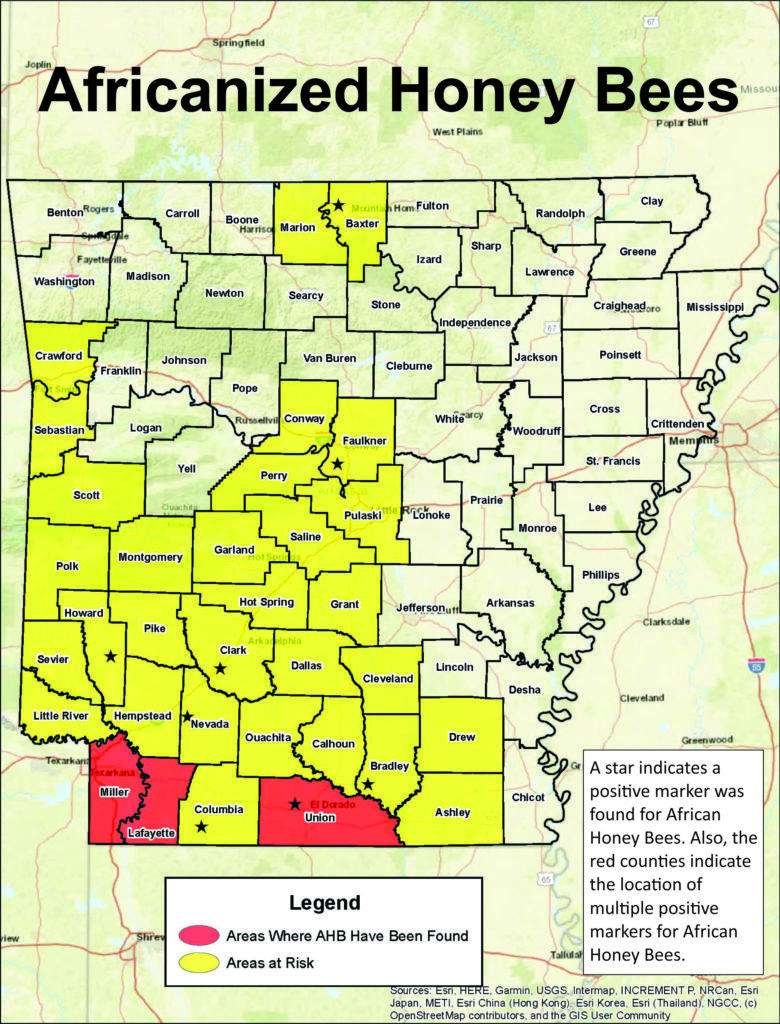Plant Industries
Serving the citizens of Arkansas and the agricultural and business communities by providing information and unbiased enforcement of laws and regulations set by the Arkansas State Plant Board
Agriculture / Plant Industries / Regulatory Section / Apiary / Arkansas Honey Bees & Africanized Honey Bees
Arkansas Honey Bees & Africanized Honey Bees
Benefits of European Honey Bees
- Provide 80% of the bee pollination required for fruit, vegetables, flowers and seed crops
- Pollinate forage crops such as alfalfa and clover which are fed to dairy and meat animals
- Produce honey, wax and other products
Hives of European honey bees (EHB) managed by beekeepers play an important part in our lives. These bees are necessary for the pollination of many crops. One-third of our diet relies on honey bee pollination.
Efforts taken to control Africanized honey bees (AHB) must assure the continued maintenance of beekeepers’ hives. If EHB were eliminated in an area, the wild Africanized honey bees would quickly fill the gap.
People can coexist with the AHB by learning about the bee and its habits, supporting beekeeping efforts and taking a few precautions.
Honey bees are not the only stinging insects people may encounter. People are often stung by other bees and wasps that look and behave differently from honey bees.
What are Africanized Honey Bees?
The Africanized Honey Bee is a hybrid of one of the several European Honey Bee subspecies (Apis mellifera mellifera, A.m.carnica, A.m.caucasia, or A.m.linguica) and the African Honey Bee (Apis mellifera scutellata). The hybrid is virtually indistinguishable in the field from the common honey bee. The AHB will set up colonies in all the same areas as the European Honey Bee (EHB) and will also nest close to or in the ground. The most noticeable difference between the two types of bees is that AHB is extremely aggressive in defense of the colony. At any perceived threat, bees can "swarm" out of the colony and attack, stinging in large numbers, sometimes in the hundreds.
Why are Africanized Honey Bees a Problem?
The way the AHB defends its nest is the main problem. AHB will respond to any threat to their nest and it does not take much for them to feel threatened. A person walking within 50 feet of a colony can trigger an attack. Operating power tools or power lawn equipment can trigger an attack from as far away as 100 feet.
The AHB will respond in higher numbers than the EHB and more bees will sting the victim. AHB will chase a victim 1/4 to 1/2 mile and will remain agitated for an hour or more after an attack. This could cause a problem for someone arriving after an attack and walking into the areas where the agitated bees are. Sting for sting, the AHB is virtually identical to the EHB. The fact that more of them will sting a victim makes them more dangerous. Some people are allergic to bee stings. If you start swelling or have trouble breathing, see a doctor. If you are stung many times, see a doctor whether or not you have symptoms.
Where are Africanized Honey Bees found?

All colored areas were previously quarantined because of Africanized Honey Bees. Beekeepers should use extreme caution when moving or relocating honeybees in these counties.
Resources and Safety Tips
- Africanized Honeybee Interagency Action Committee (114.68 KB)
- Africanized Honeybees In Arkansas Brochure (121.75 KB)
- Background Information On Africanized Honeybees (76.15 KB)
- Emergency Medical Treatment (83.62 KB)
- How To Avoid Being Stung By Honeybees (21.24 KB)
- How To Bee Proof Your Property (34.96 KB)
- How To Subdue Attacking Africanized Honeybees (90.09 KB)
- Model Fire Department Response (72.03 KB)
- Normal And Allergic Reactions To Insect Stings (52.23 KB)

